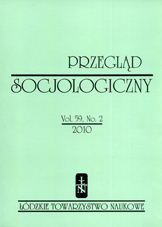Civic participation in rural Europe
Civic participation in rural Europe
Author(s): Paweł StarostaSubject(s): Social Sciences
Published by: Łódzkie Towarzystwo Naukowe
Keywords: Civic Participation; Rural Society; Europe; European Social Survey 2008
Summary/Abstract: The main goal of this article is to make an attempt at answering three main problem questions: 1) What is the general level of civic participation of Europe’s rural population in the end of the first decade of the 21st century and what is the scale of differentiation of the participation in different European countries? 2) What patterns of civic participation dominate in Europe’s rural population? And 3) Which of the below listed models explaining the differentiation of civic participation (Socio Economic Status Model; Social Capital Model or Attachment Model) is best fitted to explain the changeability of European rural population’s participation? In the article, civic participation is understood in terms of behavioural approach as activity executed by the actions of citizens in the public, political and associative spheres. The data for empirical analysis comes from the fourth round of the European Social Survey conducted in 21 European countries in 2008. This article employs only the data referring to the sample of 14 509 respondents who declared themselves as living in rural areas. The sample under research is not to be identified with farmers. The results of the study highlight four general conclusions. First, the level of civic participation of the rural inhabitants of Europe is lower than we assumed hypothetically. The mean value on the scale of 0 to 913 points is merely 1.17 points. Almost 17% of the rural inhabitants of Europe did not participate in any of the act of participation covered by the study, whereas 38% participated only in one of them. Second, our analyses revealed a high level of differentiation of civic participation in countries studied. In general, the former Eastern-bloc countries, Portugal, and Spain form a cluster of countries with the lowest level of civic participation. Therefore, these are the countries where authoritarian rules, irrelevant of their orientation, lasted longest in the 20th century Europe. Italy, Cyprus and Switzerland are the intermediary cluster between the former group and the old democracies: Netherlands, Belgium, Germany, France and UK. The highest level of civic participation was identified in the Scandinavian countries. Third, as a result of the empirical analyses conducted, four major patterns of civic participation have been distinguished: campaign participation, party participation, voluntaristic participation, and voting participation. Among them voting and campaign participation forms would be the most common modes of civic involvement in the rural part of Europe. Finally, our analyses revealed that among the three verified models explaining diversification of civic participation, it was the model of social capital that had the greatest prediction power, and not the model of socio-economic status, as was expected.
Journal: Przegląd Socjologiczny
- Issue Year: 59/2010
- Issue No: 2
- Page Range: 77-108
- Page Count: 32
- Language: English

